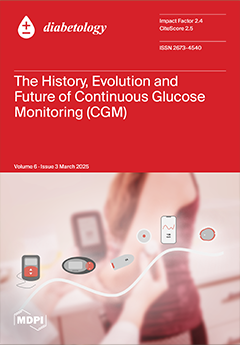Background: Diabetes-related distress (DD) significantly impacts self-management and quality of life (QoL) in individuals with type 1 diabetes (T1D). While previous research has established a strong link between DD and glycemic control in type 2 diabetes, the relationship remains less consistent in T1D.
[...] Read more.
Background: Diabetes-related distress (DD) significantly impacts self-management and quality of life (QoL) in individuals with type 1 diabetes (T1D). While previous research has established a strong link between DD and glycemic control in type 2 diabetes, the relationship remains less consistent in T1D. Additionally, continuous glucose monitoring (CGM) has been shown to improve glycemic outcomes, yet its effects on self-management and QoL are still debated. This study aimed to examine the relationship between DD, self-management efficacy (SME), and QoL in T1D, incorporating both physiological and behavioral indicators. Furthermore, differences between CGM-users and non-users were investigated. Methods: A cross-sectional study including 108 T1D patients was conducted. Participants completed several validated self-report measures, including the Diabetes Distress Scale (DDS), Diabetes Self-Management Questionnaire (DSMQ), and Audit of Diabetes-Dependent Quality of Life (ADDQoL-19). HbA1c levels and CGM usage were retrieved from medical records. Structural equation modeling (SEM) was used to examine the relationships between DD, self-management, and QoL. Results: Distress level (DDS) had a significant negative effect on SME (β = −0.47,
p < 0.001), suggesting that higher distress levels are associated with lower self-management. In contrast, SME showed no significant impact on quality of life (β = 0.03,
p = 0.779). However, the relationship between quality of life and distress was significant and negative (β = −0.37,
p < 0.001), meaning that higher distress levels are linked to a lower quality of life. No significant differences in DD, SME, HbA1c, or QoL were found among CGM users and non-users. Conclusions: DD significantly impacts self-management and QoL in individuals with T1D. Therefore, incorporating PROs on DD and on behavioral aspects of self-management alongside HbA1c levels in clinical care is essential for optimizing treatment plans and improving physical health outcomes. While CGM technology facilitates glucose regulation, it does not inherently improve QoL, which is more closely linked to distress.
Full article





